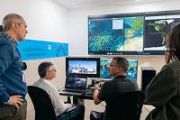
Copernical Team
GITAI Inchworm Robotic Arm passes key Lunar simulation test, achieves TRL6
 GITAI USA Inc. (GITAI), a leader in space robotics, has announced that its Inchworm-type Robotic Arm has successfully completed testing and achieved Technology Readiness Level 6 (TRL6). The tests were conducted in a thermal vacuum chamber designed to replicate the harsh environment of the lunar South Pole.
GITAI is working to significantly reduce space operation costs by developing advance
GITAI USA Inc. (GITAI), a leader in space robotics, has announced that its Inchworm-type Robotic Arm has successfully completed testing and achieved Technology Readiness Level 6 (TRL6). The tests were conducted in a thermal vacuum chamber designed to replicate the harsh environment of the lunar South Pole.
GITAI is working to significantly reduce space operation costs by developing advance SpaceX Crew-8 astronauts undock from ISS, begin journey home to Earth
 Four SpaceX Crew-8 members climbed aboard Crew Dragon Endeavour on Wednesday, closed the hatch and successfully undocked from the International Space Station to begin their 34-hour journey back to Earth. The trip home follows weather delays, scheduling conflicts and more than seven months in space.
The three NASA astronauts Matthew Dominick, Michael Barrett and Jeanette Epps, along with
Four SpaceX Crew-8 members climbed aboard Crew Dragon Endeavour on Wednesday, closed the hatch and successfully undocked from the International Space Station to begin their 34-hour journey back to Earth. The trip home follows weather delays, scheduling conflicts and more than seven months in space.
The three NASA astronauts Matthew Dominick, Michael Barrett and Jeanette Epps, along with Chinese private rocket company completes static fire test of ZQ-2E rocket
 LandSpace, one of China's leading private aerospace companies, has successfully completed a static fire test for the second stage of its Zhuque-2E (ZQ-2E) carrier rocket. The test, conducted on Monday, marks a significant milestone in the development of the ZQ-2E rocket, positioning LandSpace closer to future launch missions.
The static fire test was designed to simulate typical flight con
LandSpace, one of China's leading private aerospace companies, has successfully completed a static fire test for the second stage of its Zhuque-2E (ZQ-2E) carrier rocket. The test, conducted on Monday, marks a significant milestone in the development of the ZQ-2E rocket, positioning LandSpace closer to future launch missions.
The static fire test was designed to simulate typical flight con Human adaptation to spaceflight explored in latest NASA Nutrition Book
 NASA has released its third comprehensive review of the role of nutrition in astronaut health, building on previous works published in 2009 and 2014. The latest book, *Human Adaptation to Spaceflight: The Role of Food and Nutrition - 2nd Edition*, updates and expands on the physiological and nutritional challenges that astronauts face during space exploration.
The first edition, published
NASA has released its third comprehensive review of the role of nutrition in astronaut health, building on previous works published in 2009 and 2014. The latest book, *Human Adaptation to Spaceflight: The Role of Food and Nutrition - 2nd Edition*, updates and expands on the physiological and nutritional challenges that astronauts face during space exploration.
The first edition, published NASA's quiet space fan technology could enhance future commercial space stations
 NASA researchers have developed a Quiet Space Fan aimed at reducing noise in crewed spacecraft, with plans to share the advancements with industry for possible use in future commercial space stations.
Reducing noise in spacecraft is crucial for effective communication, clear alarms, restful sleep, and reducing the risk of hearing loss. Most noise comes from ventilation systems and equipmen
NASA researchers have developed a Quiet Space Fan aimed at reducing noise in crewed spacecraft, with plans to share the advancements with industry for possible use in future commercial space stations.
Reducing noise in spacecraft is crucial for effective communication, clear alarms, restful sleep, and reducing the risk of hearing loss. Most noise comes from ventilation systems and equipmen Chinese company to sell tickets for space tourism flights in 2027
 A Chinese company will launch sales on Thursday of two tickets for a commercial spaceflight planned for 2027.
The tickets sold by firm Deep Blue Aerospace cost 1.5 million yuan ($211,000) and are for seats on a suborbital flight in which passengers will experience five minutes of zero gravity.
They go on sale at 6:00 pm local time (1000 GMT) Thursday during a livestream shopping event ho
A Chinese company will launch sales on Thursday of two tickets for a commercial spaceflight planned for 2027.
The tickets sold by firm Deep Blue Aerospace cost 1.5 million yuan ($211,000) and are for seats on a suborbital flight in which passengers will experience five minutes of zero gravity.
They go on sale at 6:00 pm local time (1000 GMT) Thursday during a livestream shopping event ho Space agencies tracking debris from Boeing-built satellite's explosion in orbit
 The U.S. Space Force and Roscosmos are tracking potential threatening debris from a Boeing-built satellite that exploded in orbit.
Intelsat said an anomaly triggered the explosion earlier this week and the cause is under investigation.
According to the British company Spaceflux, the fragments might still be a danger to other satellites.
"The problem is that there is a lot
The U.S. Space Force and Roscosmos are tracking potential threatening debris from a Boeing-built satellite that exploded in orbit.
Intelsat said an anomaly triggered the explosion earlier this week and the cause is under investigation.
According to the British company Spaceflux, the fragments might still be a danger to other satellites.
"The problem is that there is a lot NASA testing deployable solar array on Pathfinder Mission
 NASA has begun analyzing initial flight data and images from the Pathfinder Technology Demonstrator-4 (PTD-4), which recently completed system checks, including evaluations of onboard electronics and payload support systems. One of the first images captured by the small payload camera shows Earth, marking the start of the mission's technology demonstration.
The PTD-4 mission is focused on
NASA has begun analyzing initial flight data and images from the Pathfinder Technology Demonstrator-4 (PTD-4), which recently completed system checks, including evaluations of onboard electronics and payload support systems. One of the first images captured by the small payload camera shows Earth, marking the start of the mission's technology demonstration.
The PTD-4 mission is focused on Testing heat shields for different atmospheres
This request seems a bit unusual, so we need to confirm that you're human. Please press and hold the button until it turns completely green. Thank you for your cooperation!
Press and hold the button
If you believe this is an error, please contact our support team.
185.132.36.159 : 142291c5-bb43-4946-9674-caa8da8b
Both Harris and Trump have records on space policy. An expert examines where they differ
This request seems a bit unusual, so we need to confirm that you're human. Please press and hold the button until it turns completely green. Thank you for your cooperation!
Press and hold the button
If you believe this is an error, please contact our support team.
185.132.36.159 : 93a24d93-f095-4f06-aa3a-b0b59d8a




































